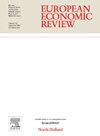The bright side of the doom loop: Banks’ sovereign exposure and default incentives
IF 2.8
2区 经济学
Q1 ECONOMICS
引用次数: 0
Abstract
The feedback loop between sovereign and financial sector insolvency, termed the “doom loop”, was a key driver of the European debt crisis and motivated an array of policy proposals. This paper revisits the “doom loop” focusing on governments’ incentives to default. We introduce a 3-period model with strategic sovereign default, where debt is held by both domestic banks and foreign investors. The government maximizes domestic welfare; thus, the temptation to default increases with externally-held debt. Importantly, the cost of default arises endogenously from the damage that default causes to domestic banks’ balance sheets. Domestically-held debt thus serves as a commitment device for the government. We show that two prominent policy prescriptions – lower exposure of domestic banks to domestic sovereign debt or a commitment not to bailout banks – can backfire, since default incentives depend not only on the quantity of debt, but also on who holds it. Conversely, allowing domestic banks to buy additional domestic sovereign debt during times of sovereign distress can avert the doom loop. In the context of a monetary union similar unintended negative consequences may arise from a backstop by the central bank (e.g., the ECB’s Transmission Protection Instrument) if imprecisely calibrated or the pooling of debt (e.g., European safe bond, also known as ESBies).
厄运循环的光明面:银行的主权风险敞口与违约诱因
主权和金融部门破产之间的反馈循环被称为 "厄运循环",它是欧洲债务危机的主要驱动因素,也是一系列政策建议的动机。本文重新审视了 "厄运循环",重点关注政府违约的动机。我们引入了一个包含战略性主权违约的三期模型,其中债务由国内银行和外国投资者共同持有。政府追求国内福利最大化;因此,违约的诱惑会随着外部持有债务的增加而增加。重要的是,违约成本内生于违约对国内银行资产负债表造成的损害。因此,国内持有的债务是政府的一种承诺手段。我们的研究表明,两个著名的政策处方--降低国内银行对国内主权债务的风险敞口或承诺不救助银行--可能会适得其反,因为违约诱因不仅取决于债务数量,还取决于债务的持有者。相反,允许国内银行在主权债务危机时购买更多的国内主权债务,则可以避免厄运循环。在货币联盟的背景下,如果中央银行的支持措施(如欧洲央行的 "传输保护工具")或债务池(如欧洲安全债券,又称 ESBies)的校准不精确,可能会产生类似的意外负面后果。
本文章由计算机程序翻译,如有差异,请以英文原文为准。
求助全文
约1分钟内获得全文
求助全文
来源期刊

European Economic Review
ECONOMICS-
CiteScore
4.70
自引率
3.60%
发文量
170
期刊介绍:
The European Economic Review (EER) started publishing in 1969 as the first research journal specifically aiming to contribute to the development and application of economics as a science in Europe. As a broad-based professional and international journal, the EER welcomes submissions of applied and theoretical research papers in all fields of economics. The aim of the EER is to contribute to the development of the science of economics and its applications, as well as to improve communication between academic researchers, teachers and policy makers across the European continent and beyond.
 求助内容:
求助内容: 应助结果提醒方式:
应助结果提醒方式:


